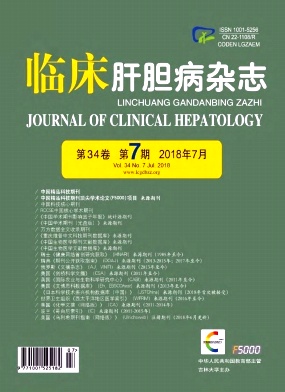|
[1]Abdominal Study Group, Chinese Society of Radiology, Chinese Medical Association.Expert consensus on clinical application of hepatobiliary-specific MRI contrast agent Gd-EOB-DTPA[J].J Clin Hepatol, 2016, 32 (12) :2236-2241. (in Chinese) 中华医学会放射学分会腹部学组.肝胆特异性MRI对比剂钆塞酸二钠临床应用专家共识[J].临床肝胆病杂志, 2016, 32 (12) :2236-2241.
|
|
[2]KITAO A, ZEN Y, MATSUI O, et al.Hepatocellular carcinoma:Signal intensity at gadoxetic acid-enhanced MR imaging—correlation with molecular transporters and histopathologic features[J].Radiology, 2010, 256 (3) :817-826.
|
|
[3]PARK HJ, CHOI BI, LEE ES, et al.How to differentiate borderline hepatic nodules in hepatocarcinogenesis:Emphasis on imaging diagnosis[J].Liver Cancer, 2017, 6 (3) :189-203.
|
|
[4]LEE MH, KIM SH, PARK MJ, et al.Gadoxetic acid-enhanced hepatobiliary phase MRI and high-b-value diffusion-weighted imaging to distinguish well-differentiated hepatocellular carcinomas from benign nodules in patients with chronic liver disease[J].AJR Am J Roentgenol, 2011, 197 (5) :w868-w875.
|
|
[5]NARITA M, HATANO E, ARIZONO S, et al.Expression of OATP1 B3 determines uptake of Gd-EOB-DTPA in hepatocellular carcinoma[J].J Gastroenterol, 2009, 44 (7) :793-798.
|
|
[6]KITAO A, MATSUI O, YONEDA N, et al.Hepatocellular carcinoma with beta-catenin mutation:Imaging and pathologic characteristics[J].Radiology, 2015, 275 (3) :708-717.
|
|
[7]CHOI JW, LEE JM, KIM SJ, et al.Hepatocellular carcinoma:Imaging patterns on gadoxetic acid-enhanced MR images and their value as an imaging biomarker[J].Radiology, 2013, 267 (3) :776-786.
|
|
[8]CHOI YS, RHEE H, CHOI JY, et al.Histological characteristics of small hepatocellular carcinomas showing atypical enhancement patterns on gadoxetic acid-enhanced MR imaging[J].J Magn Reson Imaging, 2013, 37 (6) :1384-1391.
|
|
[9]CRUITE I, TANG A, SIRLIN CB.Imaging-based diagnostic systems for hepatocellular carcinoma[J].AJR Am J Roentgenol, 2013, 201 (1) :41-55.
|
|
[10]RHEE H, KIM MJ, PARK YN, et al.Gadoxetic acid-enhanced MRI findings of early hepatocellular carcinoma as defined by new histologic criteria[J].J Magn Reson Imaging, 2012, 35 (2) :393-398.
|
|
[11]KOGITA S, IMAI Y, OKADA M, et al.Gd-EOB-DTPA-enhanced magnetic resonance images of hepatocellular carcinoma:Correlation with histological grading and portal blood flow[J].Eur Radiol, 2010, 20 (10) :2405-2413.
|
|
[12]FENG ZC, LIAO YJ, LIANG Q, et al.The diagnostic performance of hepatocyte-specific Gadoxetic acid disodium (Gd-EOB-DTPA) for detection of small hepatocellular carcinoma:A Meta-analysis[J].Chin J Magn Reson Imaging, 2018, 9 (1) :48-53. (in Chinese) 冯智超, 廖云杰, 梁琪, 等.肝胆特异性MRI对比剂Gd-EOB-DTPA诊断小肝癌价值的Meta分析[J].磁共振成像, 2018, 9 (1) :48-53.
|
|
[13]ZENG MS, YE HY, GUO L, et al.Gd-EOB-DTPA-enhanced magnetic resonance imaging for focal liver lesions in Chinese patients:A multicenter, open-label, phase III study[J].Hepatobiliary Pancreat Dis Int, 2013, 12 (6) :607-616.
|
|
[14]COSTA EA, CUNHA GM, SMORODINSKY E, et al.Diagnostic accuracy of preoperative gadoxetic acid-enhanced 3-T MR imaging for malignant liver lesions by using ex vivo MR imaging-matched pathologic findings as the reference standard[J].Radiology, 2015, 276 (3) :775-786.
|
|
[15]LEE DH, LEE JM, BAEK JH, et al.Diagnostic performance of gadoxetic acid-enhanced liver MR imaging in the detection of HCCs and allocation of transplant recipients on the basis of the Milan criteria and UNOS guidelines:Correlation with histopathologic findings[J].Radiology, 2015, 274 (1) :149-160.
|
|
[16]ICHIKAWA T, SAITO K, YOSHIOKA N, et al.Detection and characterization of focal liver lesions:A Japanese phase III, multicenter comparison between gadoxetic acid disodium-enhanced magnetic resonance imaging and contrast-enhanced computed tomography predominantly in patients with hepatocellular carcinoma and chronic liver disease[J].Invest Radiol, 2010, 45 (3) :133-141.
|
|
[17]CHOI SH, BYUN JH, KWON HJ, et al.The usefulness of gadoxetic acid-enhanced dynamic magnetic resonance imaging in hepatocellular carcinoma:Toward improved staging[J].Ann Surg Oncol, 2015, 22 (3) :819-825.
|
|
[18]SUH CH, KIM KW, PARK SH, et al.A cost-effectiveness analysis of the diagnostic strategies for differentiating focal nodular hyperplasia from hepatocellular adenoma[J].Eur Radiol, 2018, 28 (1) :214-225.
|
|
[19]DUNCAN JK, MA N, VREUGDENBURG TD, et al.Gadoxetic acid-enhanced MRI for the characterization of hepatocellular carcinoma:A systematic review and meta-analysis[J].J Magn Reson Imaging, 2017, 45 (1) :281-290.
|
|
[20]CHO YK, KIM JW, KIM MY, et al.Non-hypervascular hypointense nodules on hepatocyte phase gadoxetic acid-enhanced MR images:Transformation of MR hepatobiliary hypointense nodules into hypervascular hepatocellular carcinomas[J].Gut Liver, 2018, 12 (1) :79-85.
|
|
[21]ICHIKAWA S, ICHIKAWA T, MOTOSUGI U, et al.Presence of a hypovascular hepatic nodule showing hypointensity on hepatocytephase image is a risk factor for hypervascular hepatocellular carcinoma[J].J Magn Reson Imaging, 2014, 39 (2) :293-297.
|
|
[22]KOMATSU N, MOTOSUGI U, MAEKAWA S, et al.Hepatocellular carcinoma risk assessment using gadoxetic acid-enhanced hepatocyte phase magnetic resonance imaging[J].Hepatol Res, 2014, 44 (13) :1339-1346.
|
|
[23]OMATA M, CHENG AL, KOKUDO N, et al.Asia-Pacific clinical practice guidelines on the management of hepatocellular carcinoma:A 2017 update[J].Hepatol Int, 2017, 11 (4) :317-370.
|
|
[24]KUDO M, MATSUI O, IZUMI N, et al.JSH Consensus-based clinical practice guidelines for the management of hepatocellular carcinoma:2014 update by the Liver Cancer Study Group of Japan[J].Liver Cancer, 2014, 3 (3-4) :458-468.
|
|
[25]Korean Liver Cancer Study Group (KLCSG) , National Cancer Center.2014 Korean Liver Cancer Study Group-National Cancer Center Korea practice guideline for the management of hepatocellular carcinoma[J].Korean J Radiol, 2015, 16 (3) :465-522.
|
|
[26]TANG A, BASHIR MR, CORWIN MT, et al.Evidence supporting LI-RADS major features for CT-and MR imaging-based diagnosis of hepatocellular carcinoma:A systematic review[J].Radiology, 2018, 286 (1) :29-48.
|
|
[27]CHOI SH, BYUN JH, LIM YS, et al.Liver imaging reporting and data system:Patient outcomes for category 4 and 5 nodules[J].Radiology, 2018, 287 (2) :515-524.
|
|
[28]National Health and Family Planning Commission of the People's Republic of China.Diagnosis, management, and treatment of hepatocellular carcinoma (V2017) [J].J Clin Hepatol, 2017, 33 (8) :1419-1431. (in Chinese) 中华人民共和国国家卫生和计划生育委员会.原发性肝癌诊疗规范 (2017年版) [J].临床肝胆病杂志, 2017, 33 (8) :1419-1431.
|







 DownLoad:
DownLoad: